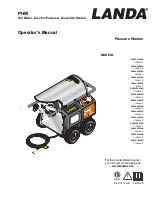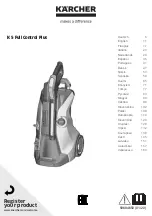
GB
IE
NI
11
The supplied cleaning agent con-
tains 5-15% anionic surfactants
Surfactants are “detergent substances” that
consist of a hydrophilic and a hydrophobic
molecule component. The hydrophobic
component encases the grime. The hydro
-
philic component bonds the grime with the
water, allowing grease to dissolve in water,
for example. With anionic surfactants, the
molecule component is negatively charged.
For example: Soap is the most well known
anionic surfactant.
Cleaning and
Maintenance
Remove the battery before carrying
out any work on the device. This
also includes connecting to the
water supply or trying to eliminate
leaks. There is a risk of electrocu
-
tion or of injury from moving parts.
Cleaning
Never direct the water jet
against the pressure cleaner,
nor clean the pressure clean-
er under flowing water. This
could give rise to the danger
of electric shock and damage
the pressure cleaner!
Always keep the pressure cleaner
clean. Do not use any detergents or
solvents.
• Always keep the ventilation slots (1)
clean and free.
• Clean the device with a soft brush or
damp cloth.
• If the nozzles (8) on the spray lance (9)
are soiled or clogged, you can remove
any foreign bodies in the nozzle using
a needle.
Rinse the nozzles with water to remove
the foreign body.
Maintenance
The pressure cleaner is maintenance free.
Ask our service centre to car-
ry out any work that is not
described in these instruc-
tions. Use only original parts.
Storage
• Empty the cordless pressure washer
completely of water.
Disconnect the device from the water
supply. Switch on the battery pressure
washer for a few seconds until no
more water emerges from the spray
lance (9). Turn off the device.
• Store all spray lances (9) vertically with
the connection side facing downwards.
• Completely empty the suction hose and
filter basket (11).
• The cordless pressure washer and ac
-
cessories are destroyed by frost if they
are not completely emptied of water.
•Store the device and the accessories
in a frost-resistant location.
Waste Disposal
and Environmental
Protection
Remove the rechargeable battery before
disposing of the device!
The device, accessories and packaging
should be properly recycled.
Instruction on how to dispose of the rechar-
geable battery can be found in the separa-
te instruction manual for your battery and
charger.
Electric appliances should not be
disposed of in the domestic gar-
bage.
Hand the tool in at a recycling centre. The
plastics and metal parts can be separated
Summary of Contents for PDRA 20-Li A1
Page 3: ...15 14 13 A 1 2 3 4 5 7 6 9 8 10 11 12...
Page 28: ...28...












































